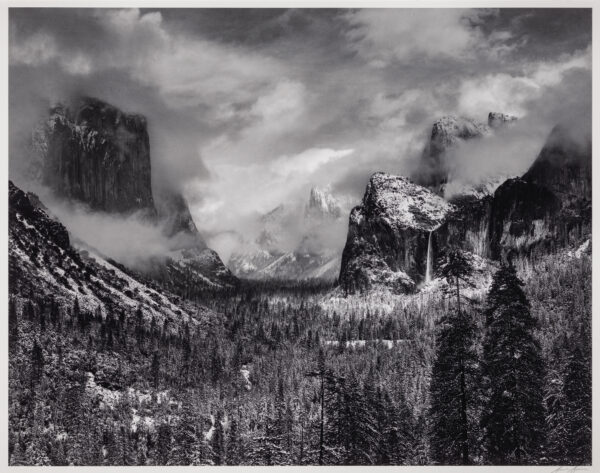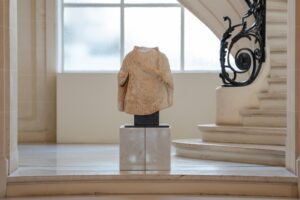Ansel Adams captured the American landscape like no other photographer before him. He owed much of his success to his beloved Yosemite National Park—where he snapped photos with his first camera, honed his observational and photography skills, and where his family scattered his ashes.
At 14 years old, Adams (1902–1984) first traveled to Yosemite with his family for a trip that forever changed him. “The splendor of Yosemite burst upon us and it was glorious,” he wrote of the trip. He saw light everywhere. “One wonder after another descended upon us.” On that trip, his father gave him his first camera—an Eastman Kodak Brownie box camera—and through that lens, he framed and shot his first photographs of Yosemite.
Yosemite’s splendor sparked Adams’s love for photography. Many times he returned to the valley, developing his creative skills and observing the nuances of sunlight as it caressed the land.
American photographer and art critic John Szarkowski saw how Adams understood the transient quality of the landscape and the light that changes it. “Ansel Adams attuned himself more precisely than any photographer before him to a visual understanding of the specific quality of light that fell on a specific place at a specific moment,” he wrote.
Adams saw Yosemite in a spiritual light that impacted him more than man-made art. “Yosemite Valley, to me, is always a sunrise, a glitter of green and golden wonder in a vast edifice of stone and space. I know of no sculpture, painting, or music that exceeds the compelling spiritual command of the soaring shape of granite cliff and dome, of patina of light on rock and forest, and of the thunder and whispering of the falling flowing waters,” he wrote in “The Portfolio of Ansel Adams.”
Choosing Pure Photography
Adams worked in the early 20th century, at a time when modern photography was a fairly new discipline. The dawn of modern photography, around 1825, had disrupted traditional art. Some painters felt that they couldn’t compete with this new art discipline that could record images quickly and accurately, yet with no nuances of light. Some believed that they had to change their painting style, so modern art movements emerged, such as impressionism, that championed impressions of light over the traditional art of realism.
Photography enthusiasts explored whether this new way of capturing images was to simply record or manipulate scenes in order to create new artworks. (Those who agreed with the latter created the pictorialism movement, which peaked from around 1885 to 1915). For instance, pictorialists might manipulate their photographs by softening a shot’s focus, creating surface textures such as brushstrokes, or printing images in one or more colors rather than in black and white.
Early in his career, Adams experimented in pictorialism, but from 1925 on, he dedicated himself to pure photography.
In 1932, he set up Group f/64 with fellow pure photographers who aspired to “define photography as an art form by a simple and direct presentation through purely photographic methods.” Adams defined pure photography in the group’s manifesto “as possessing no qualities of [technique] composition, or ideas derivative of any other art form.”
Adams shot in natural light, using small apertures and long exposures that, once developed in his darkroom, created his signature style: sharp, high-contrast, large-format landscape images.
Transcending Nature
Adams knew the power of his photographs. Early in his career, the U.S. Department of the Interior commissioned him to shoot photographs of national parks. The marketing department gave him valuable guidance on composing publicity shots, knowledge that he used throughout his images of American landscapes. He made images for the environmental nonprofit Sierra Club, a cause he advocated throughout his life.
In 1975, Adams gave one of his images, “Clearing Winter Storm,” showing all of Yosemite Valley covered with fresh snow, to a former seasonal park ranger of Yellowstone National Park—President Gerald R. Ford. As he passed the image to him, Adams said: “Now, Mr. President, every time you look at this picture, I want you to remember your obligation to the national parks.”
In Yosemite, time and time again, Adams found a certain solace and spiritual transcendence. After a bout of Spanish flu in 1918 (one of the world’s deadliest pandemics), for instance, he urged his parents, against medical advice, to let him visit Yosemite. After the trip, he felt rejuvenated, and being out in the wilderness even cured him of his compulsive cleanliness, a habit he’d developed after his sickness.
After experiencing the power of nature and solitude, Adams advocated those too. He wrote in his autobiography: “We all know the tragedy of the dust bowls, the cruel unforgivable erosions of the soil, the depletion of fish or game, and the shrinking of the noble forests. And we know that such catastrophes shrivel the spirit of the people.”
.
source: the epoc times











